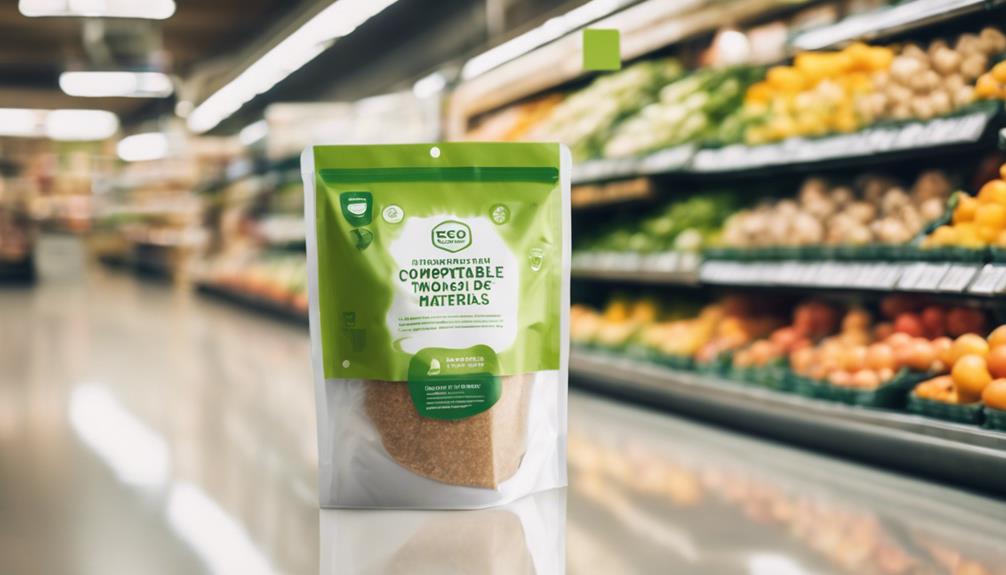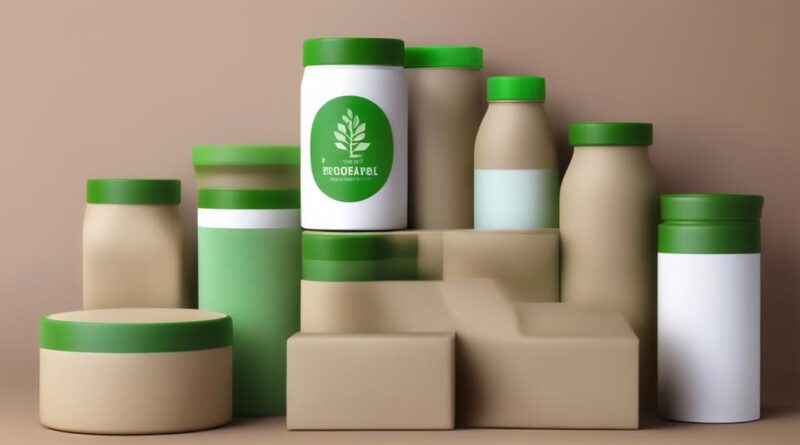Why Are Innovations in Eco-Friendly Food Packaging Crucial?
Embracing innovations in eco-friendly food packaging is crucial due to the urgent need to reduce carbon emissions and combat plastic pollution. Sustainable materials, such as biodegradable plastics and compostable options, help lower greenhouse gas emissions and minimize waste disposal costs. By opting for eco-friendly packaging, you contribute to a more sustainable future and align with the growing demand for environmentally conscious products. The advancements in biodegradable packaging offer solutions to reduce landfill waste and meet consumer preferences for eco-conscious choices. Choosing eco-friendly packaging practices is not just beneficial for the environment but also for enhancing your brand's reputation and meeting consumer expectations.
Importance of Eco-Friendly Packaging
Eco-friendly packaging plays a crucial role in reducing environmental impact throughout the entire food supply chain. By utilizing sustainable materials and innovative design, companies can significantly decrease their carbon footprint and contribute to a healthier planet.
The environmental impact of traditional packaging methods, such as single-use plastics, is well-documented. These materials not only contribute to pollution but also require significant amounts of energy to produce and transport, further exacerbating their negative effects on the environment.
In contrast, eco-friendly packaging offers a more sustainable solution. Materials like biodegradable plastics, recycled paper, and compostable packaging help reduce waste and minimize the use of non-renewable resources. Additionally, these materials often have a lower carbon footprint, leading to reduced greenhouse gas emissions during production and disposal.
This shift towards eco-friendly packaging not only benefits the environment but also offers cost efficiency for businesses in the long run. Investing in eco-friendly packaging solutions can lead to reduced waste disposal costs, lower transportation expenses due to lighter materials, and improved brand reputation among environmentally conscious consumers.
Embracing sustainable packaging practices isn't only a moral obligation to protect our planet but also a strategic business decision that can drive long-term success while minimizing environmental impact and maximizing cost efficiency.
Benefits of Organic Food Packaging
Organic food packaging offers a sustainable solution to reduce environmental impact and enhance product freshness and quality. By using organic materials such as biodegradable plastics, recycled paper, or compostable substances, these packaging solutions help lower the carbon footprint of the food industry. The use of sustainable packaging not only benefits the environment but also contributes to the overall quality of the products it contains.
One of the key advantages of organic food packaging is its positive impact on the environment. Traditional packaging materials like plastic can take hundreds of years to decompose, leading to significant pollution and harm to wildlife. In contrast, organic packaging materials break down more easily, reducing the amount of waste that ends up in landfills or oceans. This shift towards sustainable solutions helps combat the environmental crisis our planet is facing.
Furthermore, organic food packaging can enhance product freshness and quality. By utilizing materials that are better at preserving food, such as compostable films that regulate moisture levels or biodegradable containers that prevent spoilage, organic packaging helps extend the shelf life of products. This not only reduces food waste but also ensures that consumers receive fresher, higher-quality items.
Sustainable Materials in Packaging
The utilization of sustainable materials in packaging has become increasingly crucial for reducing environmental impact and enhancing product longevity. Companies are increasingly turning to green alternatives and sustainable solutions to address the growing concerns regarding traditional packaging materials' negative effects on the environment. Sustainable materials offer a promising avenue to mitigate these issues while meeting the demands of eco-conscious consumers.
Green alternatives, such as recycled paper, biodegradable plastics, and compostable materials, are gaining traction in the packaging industry. These materials help reduce the reliance on non-renewable resources, minimize waste generation, and lower carbon emissions associated with traditional packaging production processes. By adopting sustainable solutions, companies can't only align with consumer preferences for eco-friendly practices but also contribute to a more sustainable future.
Furthermore, sustainable materials in packaging play a significant role in enhancing product longevity. By using materials that are designed to be recycled or biodegraded, companies can reduce the environmental impact of their packaging throughout its lifecycle. This approach promotes a circular economy where resources are kept in use for as long as possible, thus reducing the overall environmental footprint of the packaging industry.
Innovations in Biodegradable Packaging
Embracing innovative biodegradable packaging solutions has emerged as a pivotal strategy for addressing sustainability challenges in the packaging industry. As consumers increasingly prioritize eco-conscious products, the demand for compostable solutions and eco-conscious designs has surged. Here's why innovations in biodegradable packaging are crucial:
- Compostable Solutions: Biodegradable packaging made from materials like plant-based plastics or cellulose can break down naturally into organic matter when composted. These solutions offer a sustainable end-of-life option, reducing landfill waste and environmental impact.
- Eco-Conscious Designs: Innovations in biodegradable packaging focus on reducing carbon footprint and promoting sustainability. Companies are developing packaging designs that use renewable resources and minimize energy consumption during production.
- Renewable Resources: Biodegradable packaging utilizes renewable resources like cornstarch, sugarcane bagasse, or bamboo fibers. These materials can be sustainably sourced, grown, and harvested, making them green alternatives to traditional petroleum-based plastics.
Eco-Friendly Packaging Regulations
How do current eco-friendly packaging regulations impact the sustainability efforts of the packaging industry?
Eco-friendly packaging regulations play a crucial role in shaping the sustainability landscape within the packaging industry. By enforcing regulatory compliance and setting industry standards, these regulations push companies to adopt more environmentally friendly practices in their packaging processes.
Regulatory compliance ensures that companies adhere to specific guidelines and standards set by governing bodies to reduce the environmental impact of packaging materials. This includes mandates on the use of recyclable materials, limits on harmful substances, and requirements for biodegradability or compostability. Such regulations create a level playing field for businesses, driving innovation towards more sustainable packaging solutions.
Industry standards set benchmarks for sustainable packaging practices, encouraging companies to go beyond basic compliance and strive for excellence in eco-friendly packaging. These standards often push the boundaries of traditional packaging methods, leading to the development of innovative solutions that are both environmentally friendly and practical for businesses.
Role of Technology in Packaging
With advancements in technology revolutionizing various industries, packaging has emerged as a key area where innovation plays a pivotal role in enhancing sustainability and efficiency. The role of technology in packaging is crucial in addressing environmental concerns and optimizing processes to reduce waste.
- Packaging automation: Automation technologies have transformed packaging processes, leading to increased efficiency and reduced material waste. Automated systems can precisely measure and cut materials, reducing errors and optimizing resource usage. This not only streamlines operations but also minimizes the environmental impact by decreasing the amount of material required for packaging.
- Smart packaging: The integration of smart technologies such as sensors and RFID tags enables real-time monitoring of product conditions like temperature and freshness. This not only ensures product quality and safety but also reduces food waste by providing accurate information for timely interventions. Smart packaging solutions contribute to waste reduction by extending the shelf life of products and minimizing spoilage.
- Environmental impact: Technology plays a critical role in developing sustainable packaging materials and processes. Innovations like biodegradable packaging materials and eco-friendly alternatives to traditional plastics help in reducing the carbon footprint of packaging. By incorporating technology-driven solutions, companies can make significant strides in achieving environmentally friendly packaging practices.
Consumer Awareness and Packaging

Consumer awareness regarding sustainable packaging practices significantly influences purchasing decisions in today's market. As consumers become more educated about the environmental impact of packaging waste, they're increasingly seeking products that align with their values of sustainability. Green marketing strategies that highlight sustainable practices in packaging have shown to resonate well with the modern consumer. A study by Nielsen found that 73% of global consumers are willing to change their consumption habits to reduce their environmental impact. This shift in consumer behavior is driving companies to adopt eco-friendly packaging solutions to meet the demand for more sustainable options.
Consumer education plays a crucial role in shaping perceptions around packaging waste. By raising awareness about the detrimental effects of traditional packaging materials on the environment, consumers are empowered to make informed choices. Sustainable packaging not only reduces the carbon footprint but also appeals to eco-conscious consumers who prioritize environmental stewardship.
To foster a more sustainable future, businesses must prioritize transparency in their packaging practices. Providing clear information about the materials used, recycling instructions, and the overall eco-friendliness of the packaging can help build trust with environmentally conscious consumers. Embracing sustainable packaging not only benefits the environment but also enhances brand reputation and customer loyalty in an increasingly eco-aware market.
Future Trends in Organic Packaging
As sustainability continues to drive consumer preferences, the future of packaging trends is shifting towards innovative organic solutions to meet the demand for eco-friendly alternatives. The evolution of packaging is crucial in reducing environmental impact and meeting the growing need for sustainable practices. Green solutions are at the forefront of this evolution, aiming to minimize waste and promote biodegradability. Here are some key future trends in organic packaging:
- Plant-Based Materials: One of the most prominent trends in organic packaging is the shift towards plant-based materials such as cornstarch, sugarcane fiber, and seaweed. These materials are renewable, compostable, and offer a sustainable alternative to traditional petroleum-based plastics.
- Edible Packaging: Edible packaging is a unique solution that not only reduces waste but also provides an innovative consumer experience. Products like edible films made from seaweed or rice paper offer a creative way to package food items without generating additional waste.
- Reusable Packaging Systems: Implementing reusable packaging systems is another trend that focuses on reducing single-use packaging waste. Companies are exploring options like refillable containers, returnable packaging, and packaging made from durable materials that can be used multiple times.
Conclusion
In conclusion, innovations in eco-friendly food packaging are crucial for creating a more sustainable and environmentally conscious food industry.
By prioritizing organic and biodegradable materials, implementing sustainable practices, and utilizing technology for efficient packaging solutions, we can reduce waste, carbon footprint, and overall impact on the planet.
With consumer awareness and regulatory support, the future of eco-friendly packaging looks promising, paving the way for a more sustainable food packaging industry.
